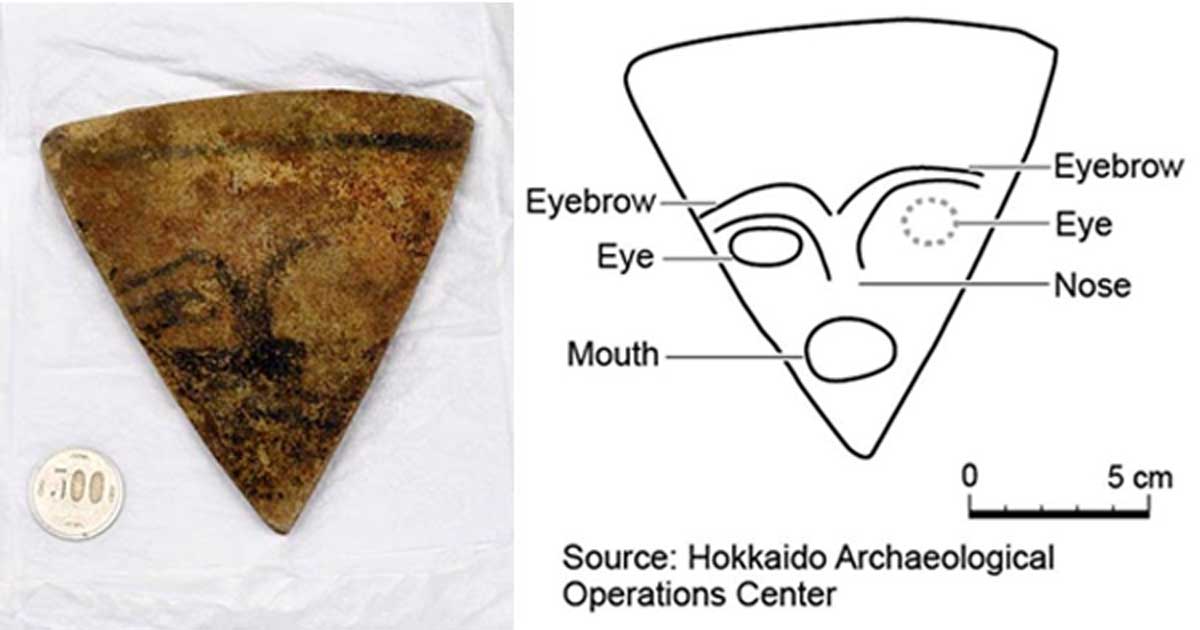4,300-Year-Old First Face Offers a Glimpse of Ancient Japanese Culture
Archaeologists in Japan have discovered what appears to be the first piece of stone painted that depicts a human face dating from the mid-Jomon Pottery Culture (2500–1500 BC). Experts describe the discovery as extremely important and unique.
Curious Paintings on the Stone
The Hokkaido Archaeological Operations Center announced on the 29 th of November that the stone fragment from the latter half of the mid-Jomon period, was discovered on October 19 and is around 4,300 years-old. The site where the excavation of the find took place is part of the Koren five archaeological sites in Kikonai, a town located in Oshima Subprefecture, Hokkaido, Japan.
As Asahi reported, archaeologists spotted the piece of stone at around fifty centimeters beneath the ground where a pit house used to stand. It measures about twelve to thirteen centimeters per side and is about 1.4 centimeters thick. Experts immediately noticed that it is flattened – possibly with a whetstone or other tools – and is shaped like an inverted triangle. Furthermore, Asahi reports that a horizontal line is drawn near the top side with a black pigment. An ellipse depicting an eye and lines shaping eyebrows and the nose are also painted on it.

A stone piece bearing the painting of a human face and found in Kikonai, Hokkaido (Image: Yoshinori Toyomane)
Usage of Stone Remains Unknown
The bad news, however, is that the stone’s use remains unknown at the moment, even though some experts have suggested that it was probably used for religious services and ceremonies in antiquity. Regardless, Yasushi Kosugi, a Jomon culture professor at Hokkaido University, excited with the discovery described it as particularly valuable from an archaeological point of view,
“The find is extremely precious in that it could help ascertain what the spiritual culture in the mid-Jomon period was like,” he stated according to Asahi.
Dr. Kosugi went on explaining what makes this particular find so rare and unique. Apparently, a painting of a human body drawn with pigments at the lower part of the earthenware, has been unearthed before at the Todonomiya archaeological site in Nagano Prefecture, a fact that indicates that such paintings were made during the Jomon Pottery Culture. However, no face drawings had ever been unearthed across Japan before, which makes this discovery really special, providing insights into this ancient and relatively obscure culture.
The Fascinating Jomon Pottery Culture
The Jomon period (10,500-300 BC), which covers a vast expanse of time, constitutes Japan’s Neolithic period. According to Metropolitan Museum, its name is derived from the “cord markings” that specifies the ceramics created during that time. Jomon people were semi-sedentary, living mostly in pit dwellings arranged around central open spaces, and obtained their food by gathering, fishing, and hunting. While the many excavations of Jomon sites have added to our knowledge of specific artifacts, they have not helped to resolve certain fundamental questions concerning the people of the protoliterate era, such as their ethnic classification and the origin of their language.
When it comes to Jomon pottery, the majority of it has rounded bottoms and the vessels are usually small. This shows that the vessels would typically be used to boil food, perhaps fitting into a fire. Later Jōmon pottery pieces are more elaborate, especially during the Middle Jōmon period, where the rims of pots became much more complex and decorated.

Left: Incipient Jomon pottery from Hinamiyama site. At Yokohama-shi, Kanagawa. Between 11000 and 7000 BC. (Public Domain). Right Early Middle Jomon pottery, between 5000 – 4000 BC. (CC BY-SA 3.0)
The Middle Jomon period, from which comes the newly found fragment of painted stone, marked the high point of the Jomon culture in terms of increased population and production of handicrafts. The warming climate peaked in temperature during this era, causing a movement of communities into the mountain regions. Refuse heaps indicate that the people were sedentary for longer periods and lived in larger communities; they fished, hunted animals such as deer, bear, rabbit, and duck, and gathered nuts, berries, mushrooms, and parsley. Early attempts at plant cultivation may date to this period. The increased production of female figurines and phallic images of stone, as well as the practice of burying the deceased in shell mounds, suggest a rise in ritual practices during that period.

More elaborate rim typical of the Middle/ Late Jōmon period (c. 4000 BC- c. 200 BC) (CC0)
Top image: Left, A stone piece bearing the painting of a human face and found in Kikonai, Hokkaido (Yoshinori Toyomane) Right. A Sketch of the impression. (Source: Hokkaido Archaeological Operations Center)



















